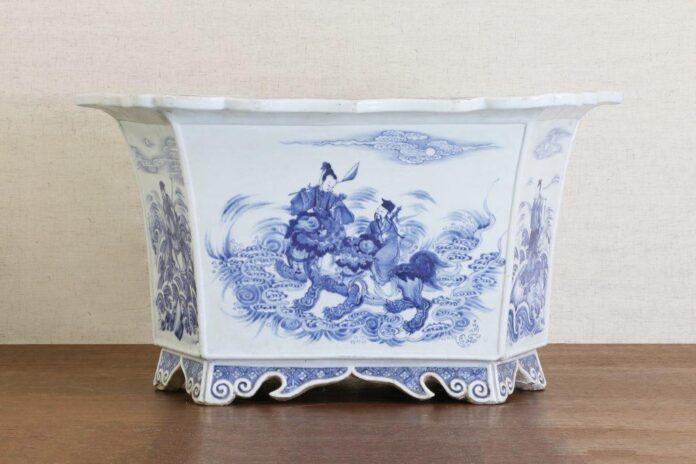Sworders Fine Art Auctioneers, in Essex, England, sold a Chinese blue-and-white ceramic jardinière to a Chinese buyer for nearly 200 times its $610 high estimate, bringing the hammer down at nearly $120,000 (about $155,550, with buyer’s fees), and making it the top item in the May 19 Asian art sale. Its most recent owners used it to grow hyacinths, but even earlier, during the Qing dynasty (1636-1912), it had likely been put into service to display flowers and bonsai trees at court.
The hexagonal piece measures nearly two feet across and features scenes of the Eight Doaist Immortals, a frequent subject in Chinese art, literature, and popular culture, who can bestow life or destroy evil. (They are also sometimes called the Eight Genies or, more colorfully, the Eight Drunken Immortals, since they are sometimes described as big drinkers.) It bears the mark of the Kangxi Emperor, Shengzu of Qing, who reigned from 1662 to 1720, making him the longest-reigning leader in Chinese history.

A Chinese blue and white jardinière, Qing dynasty (1644-1911). Courtesy Sworders.
According to the auctioneer, a strikingly similar piece stands in the Forbidden City in Beijing to this day.
Blue and white porcelains are arguably the most recognizable ceramic object, featuring cobalt ore that was first imported from Persia. They grew in popularity during the Yuan dynasty (lasting from the 13th to 14th centuries) and remained prominent in the Ming (14th to 17th centuries) and Qing (17th to 20th) periods.

A Chinese blue and white jardinière, Qing dynasty (1644-1911). Courtesy Sworders.
It’s not quite clear when the piece came into the hands of the seller’s family, since their ancestors served as missionaries in China in the late 19th century and brought back some precious objects. The seller’s parents also worked at Sotheby’s in the 1950s and 60s, according to the auctioneer.
The sale took place at the Swirders’ sale room in the village of Stansted Mountfitchet, about 35 miles north of London. Other items on offer that day included a Chinese bronze bodhisattva that fetched about $74,000 and a Chinese bronze incense burner that went for nearly $36,000.
Chinese porcelains have commanded stratospheric prices at auction recently. A Qing period bowl measuring just four inches across (featuring naturalistically colored flora and fauna) commanded $25.4 million at Sotheby’s Hong Kong in April, and a blue and white Ming vase sold at Sotheby’s Hong Kong in 2011 for $21.6 million after a 10-minute bidding contest.
More Trending Stories:
A Sculpture Depicting King Tut as a Black Man Is Sparking International Outrage

























